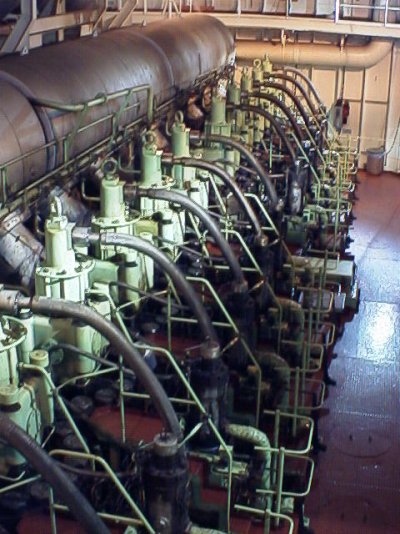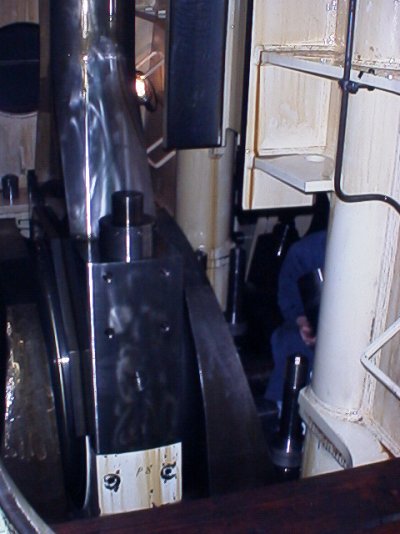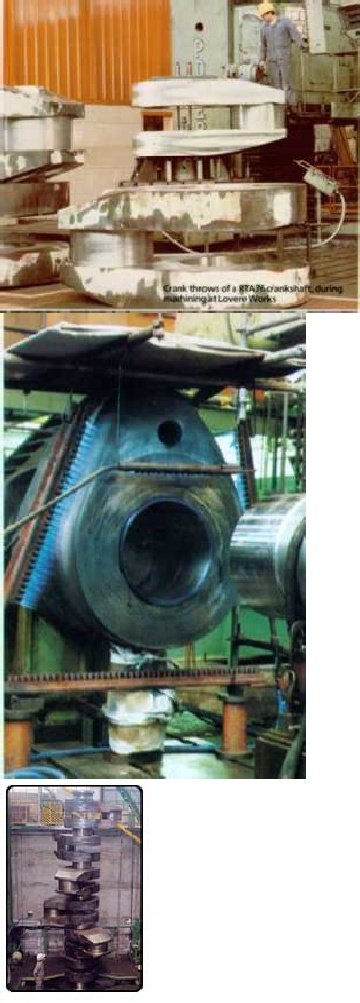You are using an out of date browser. It may not display this or other websites correctly.
You should upgrade or use an alternative browser.
You should upgrade or use an alternative browser.
Engine Replacement- here is one
- Thread starter charles
- Start date
The friendliest place on the web for anyone who enjoys boating.
If you have answers, please help by responding to the unanswered posts.
If you have answers, please help by responding to the unanswered posts.
healhustler
Guru
- Joined
- Oct 2, 2009
- Messages
- 5,198
- Location
- USA
- Vessel Name
- Bucky
- Vessel Make
- Krogen Manatee 36 North Sea
Well, for sure the installation of those babies would guarantee a "stand-up" engine room.
ARoss
Guru
- Joined
- Nov 17, 2007
- Messages
- 637
- Vessel Name
- My Yuki
- Vessel Make
- 1973 Marine Trader 34
Am I correct that this is a seven cylinder engine? I wonder what that crankshaft looks like.
RT Firefly
Enigma
Greetings,
bent....
bent....
Nomad Willy
Guru
I wonder if it's cast, built up or machined. The latter not likely of course. The number of cylinders just dictates valve and injection timing basically and of course the crankshaft journal positions is the same on most engines but V4s, V6s, inline twins and probably many others fairly commonly have more than one variant. There aren't many 7 cyl engines though and I've never heard of an 11 cyl but I wouldn't be surprised if one exists. Ric B would prolly know that one.
RickB
Guru
- Joined
- Oct 20, 2007
- Messages
- 3,804
- Vessel Make
- CHB 48 Zodiac YL 4.2
RickB
Guru
- Joined
- Oct 20, 2007
- Messages
- 3,804
- Vessel Make
- CHB 48 Zodiac YL 4.2
I wonder if it's cast, built up or machined. The latter not likely of course.
The cranks are built up of forged pieces. The throws are heated and pressed together with the journals then machined.
It is not unheard of for a crank throw to slip on the journal.
Attachments
BruceK
Moderator Emeritus
- Joined
- Oct 31, 2011
- Messages
- 13,347
- Vessel Name
- Sojourn
- Vessel Make
- Integrity 386
Rick, A question on engine rebuilding. Years ago I visited the Sydney navy base where they were refitting a submarine. I was told the diesel engine was being rebuilt and after rebuild they would run it a while and then dismantle it to check the rebuild was perfect.
That seemed a good idea,especially for a sub,but I could see a circularity in it, like after pulling it down to check the rebuild you`d need to run it and pull it down to check...you get the idea.
Is it standard practice to do a pull down check after a major engine rebuild? BruceK
That seemed a good idea,especially for a sub,but I could see a circularity in it, like after pulling it down to check the rebuild you`d need to run it and pull it down to check...you get the idea.
Is it standard practice to do a pull down check after a major engine rebuild? BruceK
RickB
Guru
- Joined
- Oct 20, 2007
- Messages
- 3,804
- Vessel Make
- CHB 48 Zodiac YL 4.2
Is it standard practice to do a pull down check after a major engine rebuild? BruceK
I agree with you in that it would be a never ending circle of assembly run and dismantling.
Can't say as I have ever heard of doing such a thing, we check oil strainers and look at parts that can be viewed by opening a crankcase door or that sort of thing but it is foolish to take a bearing apart of anything as invasive as that.
If the engine is assembled according to specs and test run satisfactorily then it is as it should be. The Navy (and the aviation industry) used to work on the concept of dismantle and inspect at certain hours but has since discovered that doing so created more problems and did more damage than normal wear and tear. That is where condition monitoring came from, do oil samples, vibration analysis, bearing temperature recording, cylinder indicator logging and so on and leave the darn thing alone to do its job.
Nomad Willy
Guru
Rick B,
Suzuki 2stroke and early Suzuki 4stroke motorcycles had pressed together built up cranks. Great engines all. I had quite a few motorcycles of both configurations including two 750cc water cooled 2 stroke 3cyl motorcycles often called "Water Bufalos". I really liked them. But the built up cranks were probably expensive to make as the type didn't last for more than a few years after the 4strokes came out. I preferred the 2strokes. Rotating or twisting a pin was a very rare occurannce and I believe only happened in racing units.
Suzuki 2stroke and early Suzuki 4stroke motorcycles had pressed together built up cranks. Great engines all. I had quite a few motorcycles of both configurations including two 750cc water cooled 2 stroke 3cyl motorcycles often called "Water Bufalos". I really liked them. But the built up cranks were probably expensive to make as the type didn't last for more than a few years after the 4strokes came out. I preferred the 2strokes. Rotating or twisting a pin was a very rare occurannce and I believe only happened in racing units.
I wonder if it's cast, built up or machined. The latter not likely of course. The number of cylinders just dictates valve and injection timing basically and of course the crankshaft journal positions is the same on most engines but V4s, V6s, inline twins and probably many others fairly commonly have more than one variant. There aren't many 7 cyl engines though and I've never heard of an 11 cyl but I wouldn't be surprised if one exists. Ric B would prolly know that one.
There are 5 cylinder engines still being made for cars, trucks and large commercial ships. We use to have a 1998 Volvo with a 2.5 liter, 5 cylinder engine. The one time we bought spark plugs, the guy at Auto Zone asked if I was buying a spare.
sunchaser
Guru
- Joined
- Apr 9, 2008
- Messages
- 10,195
- Location
- usa
- Vessel Name
- sunchaser V
- Vessel Make
- DeFever 48 (sold)
The November issue of Car and Driver tests a new VW Passat with a 5 cylinder gas engine. This basic engine dates back to the early 80s Audi that people kept pushing down the gas thinking it was the brake pedal resulting in the the infamous unintended acceleration fantasy.
JD
Guru
The November issue of Car and Driver tests a new VW Passat with a 5 cylinder gas engine. This basic engine dates back to the early 80s Audi that people kept pushing down the gas thinking it was the brake pedal resulting in the the infamous unintended acceleration fantasy.
Which resulted in the system we have now. Must have your foot on the brake to get the selector out of park.
The five cylinder AUDI engine was a very smooth running engine.
Similar threads
- Replies
- 17
- Views
- 2K
- Locked
- Replies
- 1
- Views
- 261



